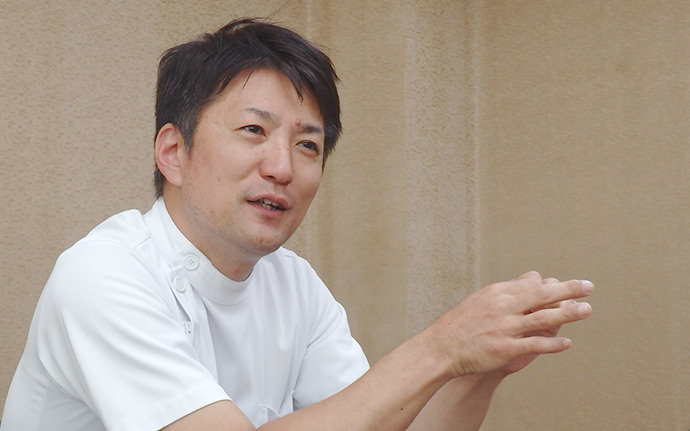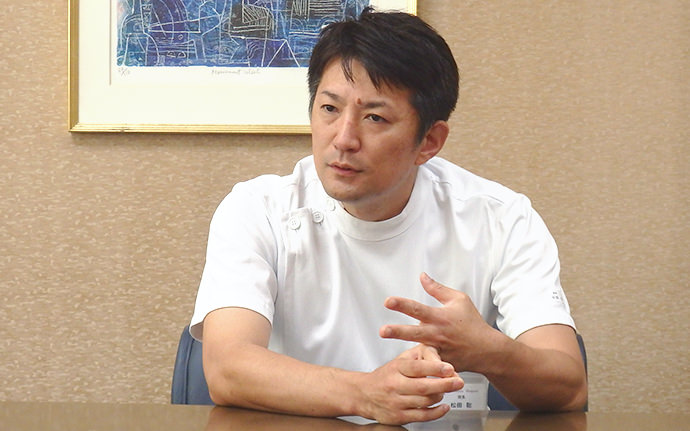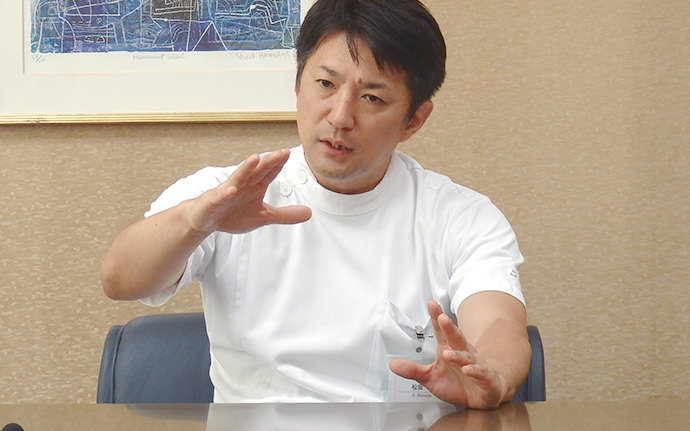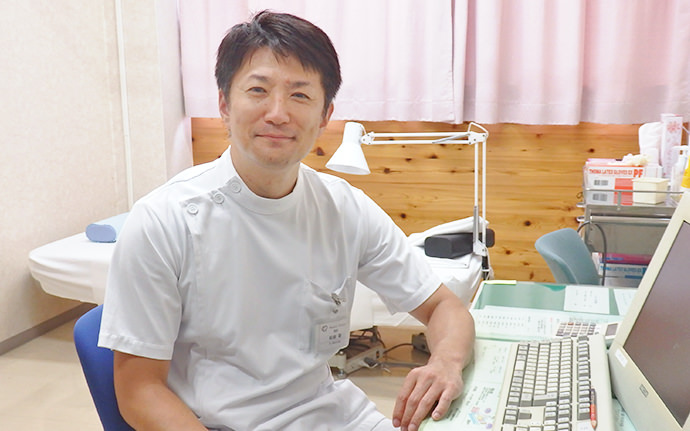
Typical symptoms are anal bleeding, prolapse, and pain. Difficult defecation, dyschezia, may also occur. This is related to pain, and especially patients with anal fissure cannot pass stools due to pain. Repeated recurrences of anal fissure often cause anal stenosis, a gradual narrowing of the anus. The condition worsens with every bowel movement and may result in the necessity for surgery. There are many patients complaining of anal or perianal discomfort, which includes such symptoms as "anorectal tingling after defecation" and "feeling something swollen." These are thought to be signs of worsening hemorrhoids due to temporary damage to the anal canal. Such symptoms are temporarily alleviated, but generally worsen overall while repeatedly alternating remission and worsening. It is important for patients to visit a hospital soon after any abnormal feeling is noted.
Anal bleeding and pain are symptoms for which patients must visit a hospital. Not all anal pain and bleeding are due to hemorrhoids. Rectal cancer can be a cause of anal pain, so caution must be exercised. When examining patients, proctologists pay much attention to the absence or presence of cancer.
In many patients, dark red bleeding, not bright red bleeding, is found during digital examination. Other than colorectal cancer, there are other possible diseases such as enterocolitis, Crohn's disease, and ulcerative colitis. If any such diseases are suspected, only an enema is performed immediately and a short colonoscopy is introduced for observation. In many cases, ischemic enterocolitis or intestinal diverticular bleeding is the cause of such dark red bleeding. Bleeding due to these conditions is often mistaken as bleeding from hemorrhoids. As mentioned above, there may be a number of causes. In case of bleeding occurring, the patient must visit a hospital, without delay.

Anal bleeding and pain are symptoms to be treated immediately. Colonoscopy revealed polyps in more than 10% (about 13%) of patients scheduled to undergo surgery for hemorrhoids at our hospital. Cancer was found in 0.4% of patients, and there is a probability that cancer is found in 4 out of 1,000 patients. According to these statistics, it is recommended that patients with anal bleeding and pain visit a hospital, not assuming that their symptoms are due to hemorrhoids. Early-stage colorectal cancer can be resected by endoscopic excision, but may progress to advanced colorectal cancer if left untreated, necessitating laparotomy. Therefore, early cancer detection is important. Rectal cancer can be detected easily by digital examination, so digital examination is very important.
We observe that farmers in our area frequently have to squat to carry out their agricultural work, which is detrimental to the anus. I think that, when people remain in a squatting position, excessive pressure is put on the anus, causing anal stretching. Drivers who drive a vehicle for long hours and desk workers; i.e., persons, whose perianal blood flow is constantly poor, must take precautions not to have anal disorders. Playing golf frequently can also be detrimental to the anus. There are many people whose anal region has become swollen after playing golf because the golf swing puts much pressure on the anus. At our hospital, golf is included in the forbidden items after anal surgery listed in the instruction sheet provided to patients. For prophylaxis against hemorrhoids, it is recommended that patients immerse themselves in a bath (wherever possible). It is more important to improve blood flow than to keep the body clean. It is recommended for patients to immerse themselves in a bathtub even in summer, and patients are also instructed to cover their lower half of the body using a towel to prevent coldness of the hips.
Anal fistula is caused by bacterial entry into a small hole between the rectum and the anus. It is predominantly seen in male patients. There are some opinions that men are more likely to have bacteria in the hole because they have higher anal sphincter pressures and also that male hormones are related to anal fistula. The reason is unknown, but actually there are many male patients with anal fistula.
Moreover, it has been pointed out that overweight people tend to be more likely to suffer from "anal fistula." Overweight people may be susceptible to infections due to diabetes mellitus and other conditions, and consequently, many overweight people may be suffering from anal fistula. Anal fistula is often caused by diarrhea, and there are many patients who experience swelling of the anus after drinking too much alcohol. Of course, there are female patients with anal fistula. It is known that women are more likely to have anal fistula in the front (genital side) than men.
In general, hemorrhoids (piles) and anal fissure are less painful for elderly patients. Many elderly patients present with the following complaints: "feeling uncomfortable due to prolapsed hemorrhoids (piles)," "pressing on hemorrhoids (piles) while sitting" and "soiling with blood." This is said to be related to the pressure in the anal canal. It is considered to become difficult for elderly patients to feel anal pain due to decreased anal canal pressure.
"Infantile anal fistula" may occur in infants. This condition requires no treatment, spontaneously resolving in many cases. For children still suffering anal fistula until the age of around 12 years, surgery will be considered when their body becomes large enough. There are also many children with "anal fissure" due to constipation; such patients are often treated with laxatives or enema at a pediatric clinic. For children with constipation, it is most important to use drugs appropriately to form the habit of smoothly passing stools spontaneously once daily.
It is recommended to choose a hospital where a doctor experienced in gastrointestinal surgery is available. Surgeons experience clinical practice at a proctology department as a trainee; they can treat patients based on knowledge of the general course of treatment. It is not recommended to receive treatment from a doctor who rejects patients complaining of pain or bleeding as soon as symptoms seem to be alleviated. For example, even if no abnormalities are apparent by the doctor’s routine physical examination, rectal prolapse may be found at the inner portion of the anal canal on detailed examination. From my experience, I have learned much from patients’ comments. Patients who are not convinced by their doctors’ explanation must seek a second opinion at another hospital.
At our hospital, ointment or oral drugs are commonly used as the initial treatment of hemorrhoids (piles). The treatment of hemorrhoids is also associated with dietary habits, job demands, and other stressful things. At our hospital, we provide a set of instructions titled "10 Tips for Treatment and Prevention of Anal Diseases," so patients can improve their lifestyle as it relates to hemorrhoids. If there is no response to drug therapy for about one month, surgery will be considered. At our hospital, both ligation and excision (LE) and aluminum potassium sulfate and tannic acid (ALTA) therapy are in use. At our hospital, LE and ALTA therapy account for 70% and 30%, respectively, of all cases. The decision is made after consultation with the patient. The hospitalization period is 1 night and 2 days for ALTA therapy, and 1 week for LE. LE should be performed for complete cure; however, most working men choose ALTA therapy because they cannot be absent from work. On the other hand, many women choose LE for complete cure while taking a rest.
*ALTA therapy: Sclerotherapy for internal hemorrhoids in which hemorrhoids are sclerosed and shrunken by injection.
Anal fissure may repeatedly recur alternating tearing and healing, during which time narrowing of the anal canal or swelling around the anal fissure may occur. "Anal fissure," "external skin tag," and "internal polyp" are 3 major conditions that may coexist, and these further aggravate symptoms. The initial treatment of anal fissure is the same as that of hemorrhoids (piles) except that for anal fissure an ointment is applied to relax the anal sphincter. If there is no alleviation of symptoms, surgery is required. Surgery is not to cure the anal fissure itself, but to alleviate the anal fissure by widening the anal canal to return it to the former state. A surgical procedure termed "anoplasty" is performed; however, if the anal canal is excessively widened, fecal incontinence may occur. Therefore, it is performed with the greatest care. The causes of anal stenosis vary, such as narrowing of the passage for stools due to rigid muscles and tightening and narrowing of the anal canal due to hardening of the perianal skin. It is important for physicians to identify the cause of anal fissure and to determine treatment suitable for the patient.

For anal fistula, surgery may be the sole effective treatment. The most common conventional procedure for anal fistula involves the formation of a fistula tract for pus drainage from the anal canal to the perianal skin and looping a rubber band through the tract and gradually tightening the band to slowly incise the fistula. With this method, such incisions heal gradually during the duration of 4 to 5 months. Meanwhile, "sphincter preservation" which does not involve incision of muscles has been employed in recent years at specialized hospitals. At our hospital, "ligation of intersphincteric fistula tract (LIFT) surgery" is performed, which involves ligation of the intersphincteric tract (for pus drainage) close to the internal opening and removal of the intersphincteric tract, scraping out the remainder of the fistulous tract not related to the external sphincter muscle. Bacteria cannot enter the external fistulous tract, and this portion withers and disappears.
Regarding criteria for symptoms requiring a revisit, patients who have noticed recurrence of similar symptoms should revisit the hospital. In patients in whom similar symptoms have recurred after once being resolved, such symptoms are mostly more severe than before. Such patients must understand what symptoms are serious and require treatment. Severe symptoms are more difficult to treat, so keep in mind the significance of early treatment.
"Functional anorectal pain" is included in anorectal disorders. This is a condition in which intense pain often occurs at night, but not every night; the frequency differs among patients, such as once weekly, monthly, or yearly. The cause remains unknown, and it is difficult for patients to receive a diagnosis of this pain at a hospital where there is no specialist available. In many cases, non-specialists may say “no pain exists and it is the patient’s imagination.” However, what is common to all these patients is that the pain is so intense that they want to call an ambulance; it lasts for about 15 minutes. It is said that excessive anal muscle contractions and the pudendal nerves are involved, but such pain is hardly known as a disease. I am currently treating some patients suffering from this pain. Some of them felt relieved and symptoms were also relieved after the establishment of a diagnosis of this pain. Specialists can provide patients with the abovementioned information on this pain even if they cannot treat or cure this condition. Consult with a specialist.
It is generally accepted that fluid intake is important. It is sometimes misunderstood that eating less can relieve constipation. This is clearly counterproductive. There is a mechanism for bowel movement in which adequate oral food intake leads to increased fecal volume and feces accumulated in the rectum produce a sensation of increased pressure in the anal canal to evacuate the rectum. Eating less means less fluid, resulting in decreased fecal volume, which is inadequate to produce a sensation of increased anal canal pressure. There is no need to eat more than necessary, but it is recommended to eat three meals a day. Laxatives are effective, but irritant laxatives may impair this bowel movement mechanism and are not recommended. When there is no bowel movement for 3 days, some people may promptly use a laxative, thinking that “they have to move the bowels.” However, it is important to wait for spontaneous bowel movement if there is no abdominal bloating or nausea. Even if there is no bowel movement for 3 days, there is probably no problem if you have a bowel movement on the fourth day. Be patient.
Fiber intake is important, but a dietary imbalance is not good. There are two types of dietary fibers: water-soluble fibers and insoluble fibers. These fibers are good for constipation; however, persons who keep eating green vegetables only may be constipated. In addition, necessary amounts of fibers cannot be taken from raw vegetables only, so it is recommended to eat cooked vegetables. Food ingredients not to be taken after treatment include irritants such as wasabi (Japanese horseradish), red pepper, and garlic. Garlic is also an irritant although this is not widely known, so pay attention to the amount of food you eat which may contain garlic, e.g., gyoza (Chinese dumplings). Among fruits, kaki (Japanese persimmon) is not good for constipation. Tannin contained in kaki is an ingredient of antidiarrheal drugs and is likely to cause constipation. Furthermore, milk and yogurt are not good for some people. Milk and yogurt are effective for people whose stools are hard. Some people have diarrhea after ingesting milk or yogurt, so they should avoid these ingredients.
